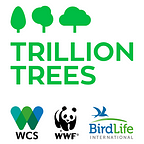John Lotspeich, Executive Director of Trillion Trees reflects on a non-carbon-centric views of forests
In the last 20 years, 75% of the untouched forest in the Amazon has become unstable. For the first time in centuries, this great expanse of rainforest, upon which so much of the earths’ biodiversity and the stability of the global climate depends, is approaching a tipping point beyond which there are profound implications for the planet.
In the current climate emergency, forests are held up as vital part of our efforts to store and even remove the increasing levels of carbon in the atmosphere. Indeed, they do this extremely well, with the remaining standing forests already helping to mitigate humanity’s continued, unsustainable level of emissions.
But on this International Day of Forests, I’m going to push ‘pause’ on the carbon conversation.
Because amidst all that carbon storing that forests do, they also happen to be home to more than half of the terrestrial species on Earth. Their rich ecosystems provide habitat for hundreds of thousands, if not millions, of living creatures from the lemur pictured in a travel brochure to the tiny beetle that transforms dead leaves into rich, fertile soil.
But like the stability of the climate, the healthy, necessary diversity of life on the planet is also under threat. Since 1970, amongst mammals alone we’ve seen a nearly 70% decline in population numbers. Some estimate that the world has lost more species in the last three decades than in the three hundred years that came before.
Forests are fortresses of biodiversity, and protecting them, and restoring them well, with the right trees in the right places in the right way, becomes more than just a way to put away some carbon, but a vibrant, dynamic investment in defending the delicate webs of living ecosystems that in turn feed us, keep our water clean, regulate our local weather and provide haven and habitat for a multitude of living things upon which we depend.
So this International Forest Day, and this week — when representatives of countries around the world are meeting in Geneva to discuss how to address this crisis of crashing biodiversity — let us imagine for just a moment that trees don’t store even one microgram of carbon.
Let us step away from calculations of carbon price per tonne, carbon stocks and flows, and long-term sequestration levels. Let us marvel instead at the great allies in the business of living that forests are, and therefore what an enormous asset they present, beyond their relationship with the chemical symbol, CO2.
Today, let the world commit to saving and restoring the world’s magnificent forests not because of the extra journey they might allow us to make in pursuit of NetZero, but because of their equally important ability to help us in our efforts to rebalance human existence with that of nature, and so redefine our own place in the world.
